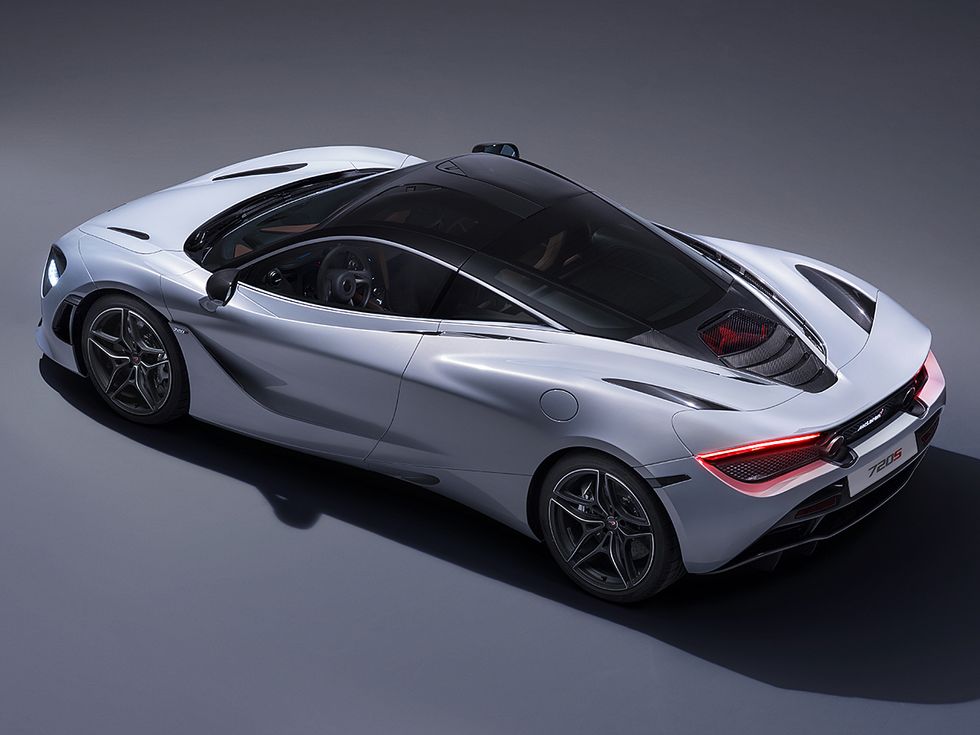2018’s Top 10 Tech Cars: McLaren 720S
For the multimillionaire who has everything


A bit cheeky, those Brits. McLaren had me test-drive its new supercar, the 720S, in Italy, home to its rivals Ferrari and Lamborghini. The 720S is the technical triumph you’d expect from the Formula One wizards who invented the carbon-fiber automobile. Yet the 720S adds a stereotypically Italian feature: knee-wobbling sex appeal, which eluded some previous McLarens, regarded by some as coldly technical.
That sex appeal includes a body that knows more about air than snowboarder Shaun White and flies through it just as effectively. Like all McLarens since the famed F1 of the early ’90s, the 720S is built on a rigid carbon-fiber structure. It helps deliver a dry weight of just 1,283 kilograms (2,829 pounds), lighter than a Toyota Prius. And yet stuffed inside is a midmounted, twin-turbo V-8 with 530 kilowatts (710 horsepower ) and 770 newton meters (568 foot-pounds) of torque.
Strapped inside this British missile, I launched my sneak attack on Autodromo Vallelunga Piero Taruffi, a Formula One test circuit a short drive from Rome. Under the car’s jet-fighter-style canopy, I enjoyed a virtual 360-degree glass bubble; I’ve never driven a midengine supercar with better outward visibility. There are roof pillars, of course, but they’re formed from carbon fiber, and they’re slimmer than a supermodel’s forearm. That greenhouse is surrounded by bravura vents that disappear when viewed from the sides. Those vents cleave deeply into the double-skinned, swing-up “dihedral” doors, and send cold and therefore dense air to radiators for the engine. To feed turbochargers at the rear, the McLaren inhales still more air through its novel, hollow “eye sockets.”
ENGINE
530 kilowatts
0-100 km/h
2.9 seconds
PRICE
US $288,000
On Vallelunga’s aptly named Curva Grande, among the fastest sections of any European track, I can feel the winged Airbrake—now 30 percent more efficient than the version on the departed 650S—as it helps slow and stabilize the McLaren under hard braking.
A dual-clutch, seven-speed transmission delivers 45 percent quicker shifts. Other eye-popping particulars include a 2.9-second rip to 100 kilometers per hour (62 miles per hour), 200 km/h in 7.8 seconds, and 300 km/h in 21.4 seconds, or 4 seconds quicker than the departing 650S model. Top speed is 341 km/h, or 212 mph.
Another feature of the 720S is hydraulically linked shock absorbers—the only ones in the auto industry—which control bumps and wheel motions so flexibly that they do the job of antiroll bars in a conventional car, limiting the body roll during fast cornering. But the company seems proudest of its new strategy for controlling the body, called Optimal Control Theory. Its algorithms now react to vehicle parameters—such as a sudden change in direction—within 2 milliseconds, using data from 12 more sensors than the old 650S had. Switched to its comfort mode, the McLaren seems to glide effortlessly along the pavement, a rare feat for such a brutally capable machine.
A chronic McLaren weakness has been the cars’ interiors, a challenge for an independent company that lacks a giant corporate parent. But the 720S is finally up to supercar par. It has a novel power-folding display, for example, which lets the driver power the entire instrument panel down into the dashboard to reduce distraction and expand those outward sightlines. All that’s left is a slim-edge display for speed and other critical data.
That cabin incorporates another company first: variable drift control, a feature that makes a science of sliding. It’s demonstrated to me by Gareth Howell, the company test driver and a many-time British touring car champion. Using a fingertip slider on a digital screen, he sets the precise angle of drift the car will allow before electronic nannies step in to prevent a full-on spin; then he slides the McLaren around the racetrack like a Hollywood stuntman. Owners can dial through nine different levels of fishtailing fun as their skills improve.
All this can be yours for as little as US $288,000. It’s still fantasy territory, but it’s a bargain for a carbon-fiber supercar with these levels of power, performance, and technology.